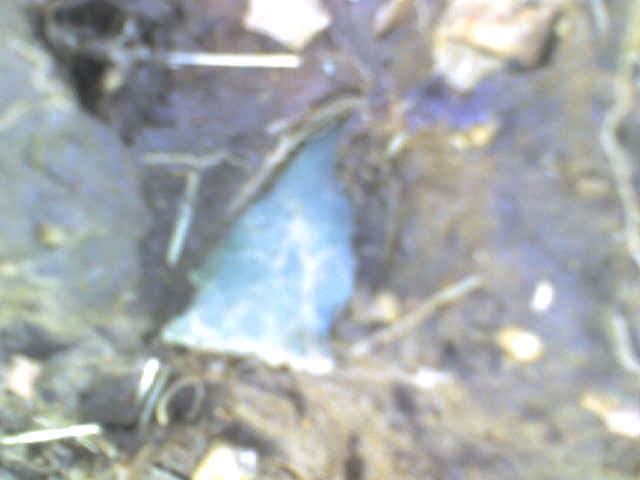The first thing you need is a pair of rubber boots. Second thing is a walking stick. Third thing is a camera. The rubber boots are for the creeks and the mud. The best time to go head hunting is right after a big rain. Rain washes the dirt off the top of the flint and the chert. But with the rain comes the mud. The walking stick is nice to have when walking long distances. The main thing I use it for is flipping up flint and chert. An all day hunt bent over, will kill your back. I would advise you to bring or pick up a stick on your hunt. The camera is something I bring just simply to document my find. I take a picture before I pick up the head, and after I have cleaned it up. I often use my cell phone camera. I will post a picture of the same head I have already posted but this picture will be before I picked it up.
What you need to look for when head hunting depends on what part of the country you live in . I will give you some examples . Lets say you live in Arizona, you would look for basalt or obsidian . If you live in Missouri, like I do then you would look for mostly chert. Particularly Burlington chert ,flint or rarely some red jasper.If you lived in Texas, you would look for flint. Texas in my opinion has the bet flint. So, you get the idea. You need to look for your states native chert's, flint, rocks and minerals. Keep in mind, Indians traveled and traded heads. you could find a Arizona obsidian head in Missouri or a Missouri Burlington chert head in Arizona.It is extremely rare, but it dose happen. Always remember, Indians traveled hundreds of miles.
OK,lets say you are walking a plowed field and it has just rained .You need to keep your eyes open for any kind of rock that stands out in color, shape or size. Large pieces are often over looked because we think of heads as small and triangled shaped. A good head hunter is always looking for all artifacts left behind. Some of these are diggers, knifes, scrapers,and grinding stones. All of these items are much bigger than your average head. We will talk about them in future postings. Color is one thing that gets my attention more then anything else. Indians were and still are a very colorful people . An example is how they painted there horses and faces for various reasons. Heads are no different. Indians would often look for bright and unusual colored rock to make their heads out of. Take for example, the picture I posted if you look close it is green in color. Indians also heat treated some rock. It makes it easier to work. One of the side effects of heat treating is that it changes the color of the rock. For example white Burlington chert will turn a bright pink or red when heat treated.
You should also look for flakes and chips . I don’t know how many of you have ever done any flint knapping, but there is a tremendous amount of chips and flakes . For those of you who do not know what flint knapping is, it is the modern term used when talking about the making of heads. Keep your eyes open for flakes and chips, it is a good indicator that heads are around. The same things you look for in a plowed field is the same thing you look for in a creek.
In my next posting we will talk about scrappers and diggers.
Subscribe to:
Post Comments (Atom)





No comments:
Post a Comment